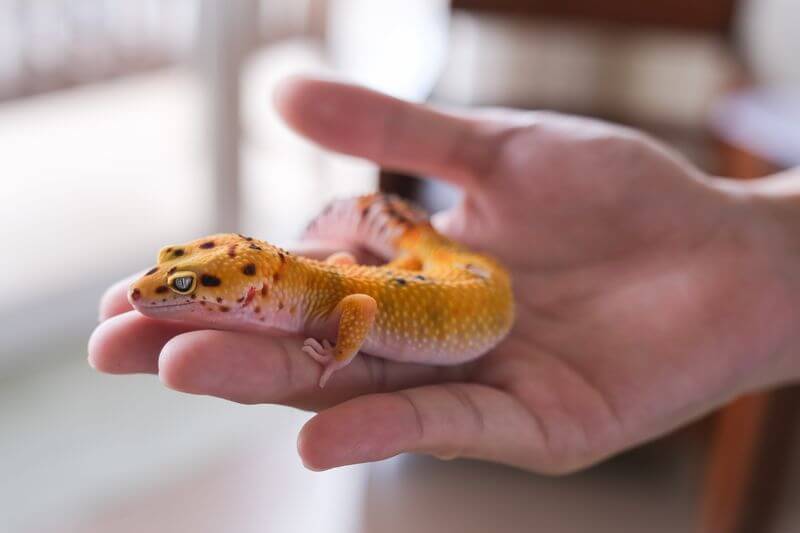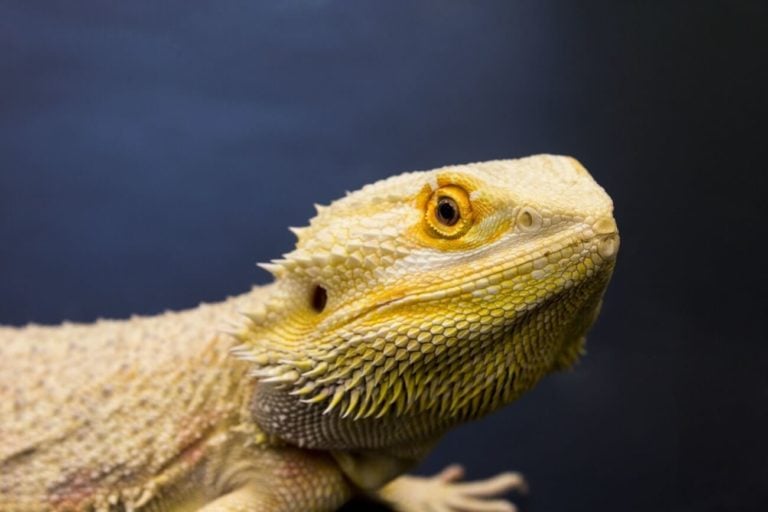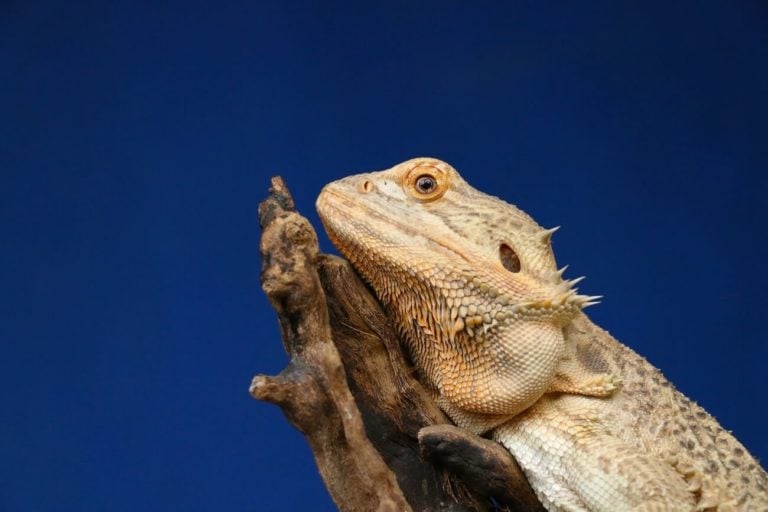Signs that a leopard gecko is sick or dying can come in many forms, and it’s your job as an owner to know what to watch out for. While these reptiles are quite tough, they’re not invincible!
This guide will teach you all of the symptoms to be aware of, so you can act quickly if needed.
Table of Contents
Signs Your Leopard Gecko Is Sick Or Dying
There are a number of signs and symptoms to keep an eye on. Here are the most important ones to know.
1. Loss Of Appetite
When your usually ravenous leopard gecko starts turning its nose up at food, it’s often a red flag signaling potential internal issues such as illness or parasites. In general, a change in appetite isn’t something to ignore, because it often indicates that your pet is dealing with some underlying health problems.
For example, impaction can result in an alarming absence of feces and present serious life-threatening circumstances. In such cases, the act of eating becomes too painful or difficult for the leopard gecko, leading to a consistent refusal of food.
On the other hand, external factors also play quite a significant role in your leopard gecko’s loss of appetite. Feeding them an improper diet can cause digestive distress and make them reluctant to eat further. Similarly, temperature fluctuations within their enclosure can induce stress and bring about reduced appetite symptoms. It’s worth noting that aggressive behavior from other geckos may trigger anxiety in your pet gecko, causing them to lose interest in eating as well.
2. Sunken Eyes
If you’ve noticed your lizard’s eyes appearing unusually sunken, don’t brush it off. This could be a serious sign that your leopard gecko is sick or dying. Leopard geckos are renowned for their captivating eyes, so any change can be easy to spot.
Remember that although these geckos’ eyes may appear slightly sunken during the day as they let their eyelashes cover them, this is not the same as having constantly sunken eyes. It’s crucial not to confuse this normal daytime behavior with what might be a serious symptom.
Dehydration is often the cause of sunken eyes in leopard geckos. This could result from an overly dry enclosure, improper misting, or inadequate access to clean water. However, you shouldn’t just assume dehydration and increase water supply or misting without consulting a vet. Many pet owners have reported that sunken eyes were their first indication of a more serious underlying illness in their gecko.
In severe cases, this symptom may become prominent one to two days before death occurs. Therefore, regular monitoring and immediate veterinary consultation if you notice such changes are strongly recommended for your pet’s health and well-being.
3. Noticeable Weight Loss
Noticeable weight loss is often a sign that your leopard gecko is sick or even dying. This is because their fast metabolism usually requires them to eat frequently and maintain a healthy weight range between 50 to 100 grams (the range depends on factors like length, gender, and genetics).
Significant weight loss in your leopard gecko might arise from various causes such as poor nutrition, illness, parasitic infections, or impaction. Each of these conditions affects your pet differently. Insufficient diet leads to malnutrition, while illnesses and parasites disrupt their overall health and ability to absorb nutrients effectively. Impaction prevents proper digestion altogether, leading to rapid weight loss despite eating habits remaining unchanged.
It’s critical for you to stay vigilant about such changes in your leopard gecko’s weight because some conditions are hard to detect early, yet can lead to sudden death if not treated promptly.
4. Discharge
Seeing bubbly saliva or any form of discharge around the mouth and nose of your scaly friend should immediately ring alarm bells, as it’s often an urgent sign that they’re grappling with a serious health issue. This is not a symptom to be taken lightly; it could mean that your leopard gecko is close to death if not addressed promptly.
This discharge may indicate severe respiratory problems like pneumonia or even stomatitis, also known as mouth rot.
Such symptoms are typically accompanied by open-mouthed, raspy breathing which means they’re likely having trouble breathing. If you see this, talking with your vet immediately is usually the best course of action.
An experienced vet will be able to diagnose the underlying condition causing these symptoms and treat it appropriately to give your sick leopard gecko the best chance at recovery. Remember, when dealing with signs as severe as these, time is of the essence.
5. Abnormal Stool
When it comes to the health of leopard geckos, their poop tells a powerful story! A healthy adult leopard gecko should be producing stool 2-3 times per week, with juveniles usually pooping once a day.
The appearance of normal stool is fairly distinctive, featuring a solid brown part and a smaller chalky white part. If your leopard gecko starts producing runny or foul-smelling stools, it’s a clear sign that something’s wrong with its health.
An absence of stool can also be cause for concern. If your adult gecko hasn’t passed any droppings in five days or more, this could suggest problems with eating or digestion. It might even indicate impaction (which is a common cause of leopard geckos dying). And if your pet stops pooping altogether, that’s a serious indication of critical health issues.
This is why it’s so important to keep a close eye on your leopard gecko’s droppings. They can provide crucial insights into its well-being! If you’re ever unsure, don’t hesitate to ask your vet. It could be what saves your leopard gecko’s life.
6. Lethargic Behavior
When the lively spark in your leopard gecko dims and it starts to exhibit a sluggishness that’s uncharacteristic of its usually active nature, something’s amiss.
Lethargy could very well be a sign your pet leopard gecko is sick or dying. It might sit stationary for hours on end, frequently hide within its enclosure or linger near water bowls for extended periods. Walking slower than usual can also be a symptom of lethargy. This is even more alarming if you notice this behavior during the night when these creatures are typically more active.
More serious indicators include constant sleepiness, minimal reaction to noise or movement, or establishing one specific area in their tank as their favorite spot and refusing to move from it.
If your leopard gecko shows any of these signs, act quickly since early intervention can sometimes make all the difference. Consult with your vet to get a diagnosis and treatment options.
Expert Tip: Remember, lethargy doesn’t necessarily mean death is imminent. It’s just a red flag that warrants further investigation because something might not be right with your little scaled friend.
7. Thin Tail
A thin tail in these small creatures is a distressing indication that something’s amiss with their health. You’ll typically see this in tandem with general weight loss, but not always. If your leopard gecko’s tail starts to thin rapidly (usually within days) it should serve as a loud and clear alarm bell.
The moment you notice your leopard gecko’s tail getting thinner than a pencil, you need to act immediately. This condition usually indicates that the animal is severely malnourished or suffering from some other severe illness.
In order to understand why your lizard is losing this weight so drastically, you’ll likely need to take them to the vet. They can diagnose and treat any underlying conditions before it becomes too late for effective intervention.
8. Strange Movements Or Bending
Strange movements, such as arching the back or bending abnormally, are crucial warning signs that your leopard gecko might be sick or dying. These unusual postures can be indicative of distress and often signal health issues that require prompt attention.
For instance, if your leopard gecko is arching its back more than usual, it could potentially be experiencing pain related to gut impaction. Or, your leopard gecko might stand on its tiptoes or exhibit other abnormal behaviors due to discomfort or illness.
Remember, each movement or change in behavior communicates something about the health of your little reptile. Always keep an eye out for any unusual patterns and consult a vet immediately when they do occur.
9. Wounds
Visible wounds on your leopard gecko are alarming, signaling possible danger and indicating that they’re potentially in pain or at risk of infection. The cause of these wounds is often from superficial injuries like inadequate tank decorations, aggressive prey, or altercations with tank mates.
Heaters and lights in the enclosure can also cause severe burns if not properly managed. It’s crucial to keep a close eye on your leopard gecko’s behavior and physical condition as untreated wounds like this could lead to fatal infections.
If you notice any unusual wounds on your gecko, it’s essential to take immediate action. There are specialized products available specifically designed for disinfection of reptile wounds which you should always have handy in case of emergencies. General antiseptics and antibiotic ointments can also be used, but proceed with caution as some might not be suitable for reptiles.
Taking your lizard to the vet will be necessary for severe cases such as extensive wounds, abscesses, tumors or any changes in body shape like a swollen belly.
10. Dulled Coloring
Heartbreakingly, it’s very often too late if you notice that your vibrant little friend has lost its brilliant colors. This is a distressing symptom of severe illness or even the slow act of dying. This alarming change is typically seen as a rapid shift from vivacious shades to murky browns, yellows, or oranges.
The loss of color intensity can be startlingly fast while somewhat hard to notice in the beginning stages, which makes it crucial for you to keep a close eye on your leopard gecko’s appearance.
Expert Tip: This sudden dulling in coloration shouldn’t be confused with the papery white hue that leopard geckos adopt before they shed their skin. Instead, this transformation is more akin to a grayish-brown tinge.
This means if you observe such a drastic change in the vibrance of your leopard gecko’s coloring, you need to take them to the vet immediately. This could potentially save your leopard gecko’s life or at least alleviate some of its discomfort during its final days.
How Likely Is This To Happen?
It’s important to remember that the chance of a well-cared for leopard gecko getting sick or dying is relatively low. By adhering to proper care guidelines, you can significantly reduce any health risks.
This includes regular tank maintenance to minimize potential hazards and infection sources, as well as keeping your hands clean while handling your pet to prevent germ transmission. It’s also highly recommended to avoid housing multiple leopard geckos together in one enclosure since that can lead to stress and aggression.
In addition, providing a balanced diet with necessary supplements will ensure your leopard gecko’s optimal health. Be sure to monitor environmental parameters like temperature and humidity levels in the tank, as improper conditions may cause stress or disease. Always keep fresh water available as well!
Can A Leopard Gecko Die of Stress?
Interestingly enough, leopard geckos can die from stress. These lizards are generally hardy, yet they’re not impervious to the harmful effects of chronic stress. Stress in a leopard gecko often arises from inadequate keeping conditions such as improper temperature or humidity levels, lack of clean water or food, overcrowding, and inappropriate substrate material.
It can also stem from an injury or illness that hasn’t been properly addressed. Prolonged exposure to these negative conditions can lead to serious health issues and even death.
Remember that stress isn’t just a psychological issue, it physically affects your leopard gecko’s body as well. Chronic stress can compromise their immune system, making them more susceptible to various diseases and infections that may eventually prove fatal if left unchecked. Furthermore, signs of stress in leopard geckos like excessive hiding or tail dropping could point towards pain-related issues that increase the risk of mortality significantly if untreated.
Therefore, as an owner who wants the best for their pet, you should always strive to provide optimal care conditions and pay close attention to any changes in behavior indicative of stress or discomfort.
Conclusion
Now that you know the common signs that your leopard gecko is sick or dying, you’ll be able to keep an eye on your pet and act fast if needed.
For the most part, high-quality care will go a long way in preventing these issues from happening. But it’s always a good idea to be prepared!



